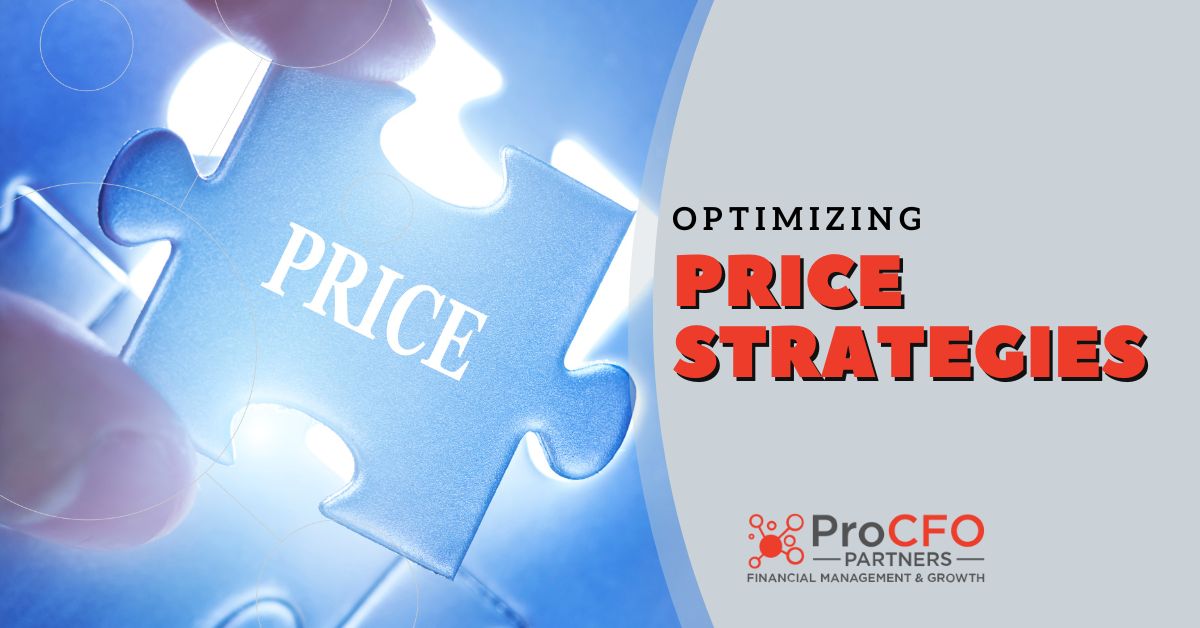Optimizing Price Strategies: Growth Beyond the Bottom Line
May 9, 2024
Effective pricing strategies are among your business’s most essential aspects for ensuring profitability and competitive market positioning. The foundation of any pricing strategy is the value your product or service provides. Read that last sentence again because your pricing strategy should not be designed around how low you can go or how high your margins can be. These are realistic characteristics to remember, but many businesses start pricing from the wrong question. Instead, evaluate what your product or service means to your customers. You must articulate what makes your product unique and why it stands out from competitors. This differentiation is not just about features or benefits but encompasses the overall value proposition to the customer. This includes considering how your product solves problems or improves the customer’s situation, which justifies a price point that reflects its true worth.
Articulating Value Clearly
Your value proposition should be clear and compelling, forming the backbone of your pricing strategy. If customers understand and appreciate your product’s value, they are more likely to be willing to pay the price you set. This is a function of aligning your product’s strengths with the customer’s needs and making sure this alignment is communicated effectively. Most customers are trying to save or spend less time, money, or hassle. Additionally, some customers are trying to have an exceptional experience above all else. Your value proposition should speak to your customers’ specific pains and ideal outcomes.
Cost Considerations
A thorough understanding of the costs involved in producing and delivering your product is critical – you have to price a thing according to what it costs to make it. This encompasses both direct and indirect costs. Knowing these costs is part of your formula so pricing covers expenses and contributes to profitability. Cost accounting methods like activity-based costing provide deeper insights into which parts of your product or service consume the most resources, allowing for more precise pricing adjustments.
Competitive Pricing Analysis
Keep an eye on your competition. Pricing is not done in isolation; understanding where your competitors position themselves can help you make insightful decisions. Regularly monitor their pricing strategies. See if you can reverse engineer their decision-making – are they making the product with less expensive suppliers? What is their marketing saying – what pain point does it seem they’re trying to connect with in customers? Sometimes, the outcomes of this analysis will require you to adapt your approach to stay competitive. Sometimes, you’ll identify ways to differentiate your value. Importantly, this analysis shouldn’t be an exercise of doing what they do unless your strategy is strictly to price equal or lower to competitors. The analysis is weighed and applied with other information to help you define your pricing strategies.
Segmenting Your Customer Base
One size does not fit all when it comes to pricing. Different customer segments may value your product differently based on their specific needs, preferences, or budgets. Effective segmentation allows for tailored pricing strategies to maximize reach and profitability across different customer groups. This can involve tiered pricing models where different product versions are offered at different price points to appeal to various segments. A few segments you might consider that impact pricing are:
- Demographic Segmentation: Segment your customer base by age, gender, income level, or education. For example, a software company might offer premium versions of its product with advanced features to professionals with higher income levels while providing a basic version at a lower cost for students or entry-level users.
- Geographic Segmentation: Tailor your pricing strategy based on your customers’ locations. This could involve adjusting prices for different countries or regions to reflect varying economic conditions, cost of living, or purchasing power. For instance, a digital content platform might have different subscription prices for users in North America versus those in emerging markets.
- Behavioral Segmentation: Focus on customer behaviors such as purchase patterns, product usage, and brand loyalty. For example, a business could offer discounted pricing or loyalty rewards to frequent buyers or long-term customers while charging standard rates to new or occasional users.
- Psychographic Segmentation: Differentiate pricing based on lifestyles, values, or personalities. A luxury car brand might target high-end customers who value prestige and exclusivity, offering premium models with luxury features and services at higher prices. More practical models with basic features are offered at more accessible prices to cost-conscious buyers.
The Psychology of Pricing
Understanding the psychological impact of pricing on buying behavior is crucial. The perceived value can often be more influential than the actual price. Pricing strategies should tap into how customers perceive the worth of a product, which might be influenced by factors like brand reputation, product quality, and overall customer experience. For instance, as mentioned earlier, some customers are looking for an exceptional experience. They’re likely willing to pay more for this and might, in fact, quickly overlook products or services that seem to be priced too low to deliver that experience.
Implementing Dynamic Pricing Models
Dynamic pricing strategies can respond to changes in market demand, competitor prices, and other external factors. For example, prices might be adjusted in real time based on inventory levels, buying trends, or promotional activities. This approach can help businesses stay agile and responsive to market conditions, maximizing revenue opportunities. For instance, Uber initiates “surge pricing” when it recognizes the need for its services is higher than usual.
The Role of Discounts and Incentives
Carefully managed discounts and incentives can be powerful tools for boosting sales. However, they need to be used strategically to avoid eroding the product’s perceived value. Discounts should be targeted, timely, and tied to specific customer actions or milestones to maintain the integrity of your pricing structure.
Develop Understanding To Define Pricing
Optimizing pricing strategies requires deeply understanding your product’s value, costs, and market dynamics. By clearly articulating the value, understanding costs, analyzing competition, and segmenting customers effectively, businesses can set prices that attract customers and enhance profitability and market positioning. Employing psychological insights and dynamic pricing models can further refine pricing strategies, ensuring they remain aligned with business goals and market dynamics.


